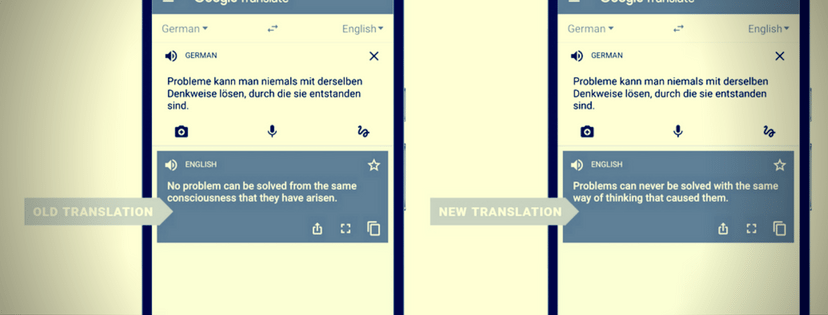1 – Found in Translation: More Accurate, Fluent Sentences in Google Translate
On Tuesday, Google rolled out the latest in its translation technologies – Neural Machine Translation. As opposed to translating sentences part by part, this new system translates sentences as a whole unit, depending largely on context to determine the most relevant translation. Neural Machine Translation is an end-to-end learning system, meaning that its built to learn and improve on its learning over time. The system is compatible at present with eight languages pairs to and from English to French, German, Spanish, Portuguese, Chinese, Japanese, Korean, and Turkish, covering more than 35 percent of total Google Translate inquiries. Google’s goal is to implement the system with all 103 languages that are currently accessed through Google Translate.
(Read the full press release at Google News)
2 – Intel Unveils Strategy for State-of-the-Art Artificial Intelligence
On Thursday, Intel’s CEO Brian Krzanich announced a range of new products and platforms designed to accelerate deep-learning and AI-driven technologies. Plans include a robust AI portfolio -the Intel® Nervana™ platform – which spotlights integrated technology from Intel’s recent acquisition of Nervana. As part of its product rollout, Intel will test first silicon (“Knights Crest”), which merges Intel’s Xeon processors with Nervana technologies and is designed with cutting-edge neural networks for deep-learning computing. Intel intends for these and other portfolio solutions to be the new industry standard and open to data professionals solving today’s toughest challenges in the AI field. Intel also announced strategic partnerships with Google – to help deliver an innovative multi-cloud infrastructure for bot businesses – and Coursera – which will provide a series of online AI courses to academics and help democratize knowledge and skills.
(Read the full press release at Intel Newsroom)
3 – Google Adds Artificial Intelligence Hotshots To Lead New Data Crunching Team
Google announced this week the addition of two, high-profile AI researchers to its new machine learning team. The machine learning unit is part of the Google Cloud business, and its new hires include Fei-Fei Li, the director of Stanford University’s Artificial Intelligence Lab, and Jia Li, the head of research for Snap (parent company of Snapchat). Both are considered experts in the area of computer vision. At a press event in San Francisco, Head of Cloud Diane Greene described the additions as part of Google’s vision to formalize artificial intelligence into its business, which includes offering machine learning-based Google Cloud products to companies. Greene made note of the fact that both hires are women, a significant acknowledgement in a field that has been long criticized to consist of mostly males.
(Read the full article at Fortune)
4 – Machine-Learning Algorithm Can Show Whether State Secrets Are Properly Classified
A researcher at Brazilian think tank Fundação Getulio Vargas and his colleagues at Columbia University have released some surprising results from a machine learning algorithm that they used to study over one million declassified State Department cables from the 1970s. The algorithm reveals insight into how humans have applied rules to official secret correspondence, how errors have affected transparency, and also uncovers some patterns in how cables go missing. Renato Rocha Souza and colleagues looked at how factors like date, sender and receiver, subject, and message content correlated with the given classification label. While incidents of false positive and false negatives arose amongst some correlations, the algorithm was able to successfully identify 90 percent of cables that were classified, with a false positive rate of 11 percent. The ongoing work could prove important to understanding consistency of classification, as well as how much this type of algorithm can reveal – when the learning itself is based on the integrity of how information has been handled by the State Department in the past.
(Read the full article at MIT News)
5 – General Electric Snaps up Berkeley-based AI Startup Wise.io, Continuing a Spending Spree
General Electric announced new acquisitions toward its year-old digital arm, GE Digital, during its annual Mind + Machines conference in San Francisco. The purchases include startups Wise.io and and Bit Stew, both specializing in data analytics. GE has been working to bolster its vision of an “industrial Internet”, a domain covering Internet-connected machines in aviation, energy, transportation, and other domains. The core of this platform is GE’s Predix software, and its recent AI-tech acquisitions will go toward bolstering the platform and powering the future of Internet-connected machines.
(Read the full article at San Francisco Business Times)
Image credit: Google News



















